An amazing variety for experimental gardeners - the Banana Legs tomato and recommendations for growing it
Every gardener wants to grow tomatoes that differ from others not only in terms of ripening, but also in their exotic appearance. Breeders willingly provide this opportunity to everyone, breeding varieties that produce fruits of unusual colors and shapes.
Often tomatoes with unusual berries are demanding to care for and are not resistant to adverse environmental factors. Therefore, novice gardeners are often afraid to grow such varieties. Many simply do not know that among them there are varieties that are no more whimsical than the most ordinary tomatoes. These include the Banana Legs tomato. Why this variety is interesting and how to care for it - read on.
General description of the variety
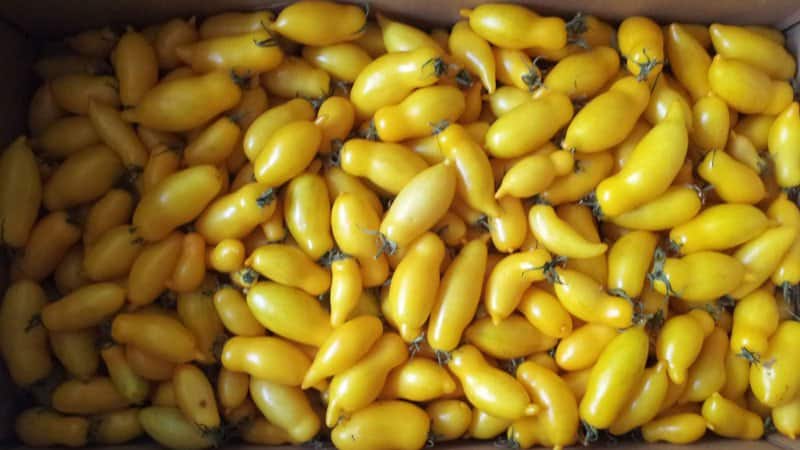
Banana legs tomatoes are a variety bred by the American breeder T. Wagner. Banana Legs is the original name of the tomato variety.
The Banana Legs variety was developed in 1988. Despite its age, it is still not included in the state register of our country. However, this does not reduce its popularity among gardeners.
This is interesting! Despite the fact that Banana Legs tomatoes were developed 30 years ago, they gained widespread popularity only in 2018. The reason for this was a video posted on the Internet.
Distinctive features
The Banana Legs variety is distinguished by unusually shaped fruits. The berries of this plant are yellow and resemble the fruit from which they get their name.Tomatoes have an elongated shape. Their length significantly exceeds the size of popular cream.
 The taste of such tomatoes has its own zest. It is sweet and sour with a slight citrus flavor.
The taste of such tomatoes has its own zest. It is sweet and sour with a slight citrus flavor.
In gastronomic terms, the variety is universal. It is suitable for both fresh consumption and whole preservation. Bright tomato sauces are also prepared from it. Such tomatoes are not suitable only for drying, because they have an insufficiently pronounced taste.
Let us also note the benefits of such tomatoes. Yellow fruits are less likely to cause allergies than red and pink ones. In addition, they contain tetra-cis-lycopene, which prolongs the youth of the body.
Due to the low growth of the plant do not need stepsoning. At the same time, the variety is characterized by high productivity.
Main characteristics
Even though Banana Legs look very exotic, they are not at all difficult to grow. This variety has excellent yields and immunity to many diseases.
Description and characteristics of the Banana Legs variety:
| Parameter | Indicators |
| Bush type | Semi-determinant. Grows up to 1 m in height in open ground and up to 1.5 m in a greenhouse. The bushes are covered with a medium number of small bright green leaves. The stems are not thick and not very durable. The inflorescences are simple. The first is laid at the level of 9-11 leaves. The next flowers are every 1-2 leaves. The fruits are set in clusters. From 7 to 13 berries grow on one cluster. |
| Growing method | In regions with southern and temperate climates, cultivation in open ground or under film cover is possible. In the northern part of Russia, these tomatoes are planted in a greenhouse. |
| Productivity | Average. One bush produces up to 6 kg of tomatoes. From sq. m harvest up to 18 kg of crop. |
| Fruit | Average.On average, one berry weighs 80 g. There are specimens weighing up to 130 g. The fruits are yellow-orange on top and yellow inside. If you look closely, there are lighter yellow stripes on the skin. The shape of the berries is elongated, slightly curved with a very pointed tip. Usually one tomato reaches a length of 8-10 cm. Sometimes fruits are 12 cm long. Tomatoes have medium fleshiness, they are juicy, but not watery. One berry has 2 seed chambers with a small number of seeds. |
| Transportability | High. Tomatoes have strong and thick skin. This allows them to be transported over long distances and stored for a long time. |
| Ripening time | Mid-season. The first harvest is harvested 100-110 days after sowing the seeds. Fruiting continues until the first frost. |
| Disease resistance | Has immunity to major tomato diseases. Not sick late blight. |
Growing seedlings
Banana legs are planted as seedlings two months before planting the plants in a permanent place. The timing depends on the climate.
In the southern regions, seeds are sown already in early March or late February. In regions with a temperate climate, seedlings begin to be grown in the second half of March. In the northern part of our country - in April.
Note! In the southern regions, it is possible to grow Banana Legs tomatoes without seedlings. It is important to understand that the harvest in this case will appear much later.
Seed preparation
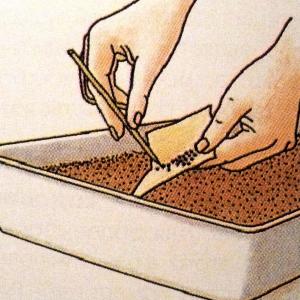
Preparing seeds is the first step in growing seedlings. It is this that prevents the occurrence of tomato diseases in the future and increases the germination rate of planting material.
Before use, you need to ensure the quality of the planting material.To do this, check the expiration dates on the packaging and sort through the seeds, removing damaged and darkened specimens. To select viable seeds, they are soaked in a saline solution (1 teaspoon of salt per glass of water). After half an hour the result is checked. Planting material that sinks to the bottom has the greatest chance of germinating.
Seed disinfection is a necessary measure, which significantly reduces the risk of plant infection. The easiest way to pickle planting material is to soak it in a weak solution for half an hour. potassium permanganate (1 g of potassium permanganate per 10 ml of water).
Seeds are also disinfected in other ways:
- «Fitosporin" Take 0.5 tsp per 100 ml of water. powder products. Use the time indicated in the instructions.
- Soda solution. Take 0.5 tsp per glass of water. soda The product is soaked in this mixture for 12 hours.
- Aloe juice. Aloe juice and water are mixed in equal proportions. The seeds are soaked for a day.
The methods presented in the list help speed up seed germination. If a solution of potassium permanganate was used for disinfection, the planting material is additionally treated with a growth stimulator (“Epin”).
How to prepare soil and containers
 Preparing for sowing seeds includes choosing a container and soil. Rare varieties of tomatoes are best planted in peat tablets, which create ideal conditions for germination. Banana legs can be easily grown in the usual way.
Preparing for sowing seeds includes choosing a container and soil. Rare varieties of tomatoes are best planted in peat tablets, which create ideal conditions for germination. Banana legs can be easily grown in the usual way.
To pre-germinate seeds, use wide but shallow containers. Wooden and plastic boxes are suitable for these purposes.
After the first true (non-cotyledon) leaves appear, the seedlings are planted in separate containers. To do this, use special pots or improvised materials.
Before use, all containers are disinfected - soaked in a dark pink solution of potassium permanganate, sterilized with hot steam or wiped with alcohol.
The soil for tomatoes should be light but nutritious. Suitable soil mixtures are sold in gardening stores, but it is easy to prepare the soil yourself.
The basis of the soil for tomatoes is chernozem mixed in equal proportions with humus. Add half a portion of peat, sand or sawdust to the resulting composition. For a bucket of this mixture take 1 matchbox of superphosphate and 1 glass of ash.
Advice. Experienced gardeners advise taking the base soil mixture for tomatoes from the place where the seedlings will be planted. This will make it easier for the plants to take root after picking.
The soil needs to be disinfected. To do this, pour boiling water or a solution of potassium permanganate over it. Another option is to calcinate the earth in the oven at a temperature of 100 degrees.
Sowing seeds
The prepared soil is poured into the container, leaving 3 cm to the edge. Planting material is laid out on the ground in rows. The distance between rows should be 2-3 cm, and between seeds – 1-2 cm.
The planting material is covered with a centimeter layer of soil on top. The soil is not compacted.
The soil is moistened with a spray bottle. Use settled water.
Cover the container with seeds with film or glass and put it in a warm place. The higher the temperature, the faster the first shoots will appear.
Seedling care
It is important to follow all the rules for caring for seedlings. In this case, it is possible to obtain healthy plants that will take root after transplanting to a permanent location.
How to care for tomato seedlings:
- The most important rule of watering: water should not get on the greenery of the plant. It is equally important to use only warm, settled water.Moisten the soil as it dries.
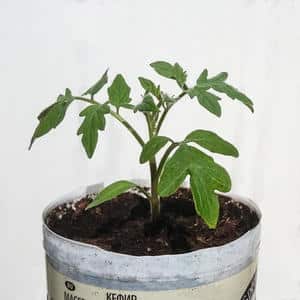
- Before seed germination and for a week after the first shoots appear, seedlings need extreme humidity. This is provided by glass or film, which is not removed at this stage.
- After the seeds germinate, they are moved to a well-lit place. Tomatoes usually don't get enough sunlight in the spring. Its deficiency is compensated using a fluorescent lamp.
- When real leaves appear on the plants, they are picked into separate containers. At the same time, do not pinch the roots of tomatoes, as this can slow down the growth of plants.
- The first feeding of seedlings is done 2 weeks after planting them in separate containers. Use complex or organic fertilizers. For one plant, take half the dose indicated on the package. Fertilizers are applied a second time after another two weeks. Tomatoes are fed for the last time 3-5 days before planting in a permanent place.
- Hardening off of seedlings begins two weeks before planting in a permanent place.. The first time the plants stay outside should not exceed half an hour. Then the time is doubled. Ultimately, the tomatoes are exposed to fresh air for 12-16 hours.
Growing rules
Banana legs are planted in a permanent place when the soil warms up. In most regions, planting occurs in May-early June.
In the south of our country, tomatoes are planted in open ground at the beginning of the last month of spring. At the same time, it is possible to plant seedlings under film in regions with a temperate climate or in a greenhouse in northern areas.
Planting tomatoes in a permanent place
Before planting tomatoes, you need to choose a suitable area of the garden.The place where tomato crops will grow should be in the most illuminated part of the garden. Otherwise, the plants will become sick, and the sweetness of their fruits will be significantly reduced.
Attention! The beds where nightshade crops grew last year are not suitable for planting tomatoes. The best precursors for tomatoes are legumes, cabbage, onions, carrots and cereals.
You should also not plant other nightshade crops next to tomatoes. Potatoes are considered a particularly dangerous neighbor.
The beds for tomatoes are prepared in the fall. They are dug up and cleared of weeds. Mullein, humus and dry lime are added to the soil.
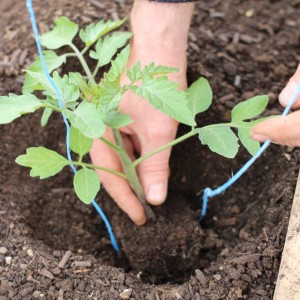 In the spring, the area where the tomatoes will grow is dug up again. All emerging roots of weeds are removed.
In the spring, the area where the tomatoes will grow is dug up again. All emerging roots of weeds are removed.
At a distance of 50-70 cm, holes are dug in rows. There should be a gap of 60 cm between the depressions in the ground. Per 1 sq. m place no more than 3 holes.
Fertilizers are added to the holes. Use ash, long-acting granular mineral fertilizer or homemade formulations.
Before planting in a permanent place, the plants are watered and fed. This must be done 3 days before the pick.
Immediately before planting, the tomatoes are removed from the pots along with a lump of earth and placed in the holes, placing the roots towards the center. It is important not to damage the roots.
Warm water is poured into the holes with seedlings and covered with soil. The next watering is possible only after 2 weeks.
Care
To get a rich harvest, you need to properly care for your tomatoes. The list shows the basic steps for growing the Banana Legs variety:
- Watering tomatoes should not be frequent, but plentiful.. In hot summers, the soil is moistened three times a week; in months with a more gentle climate, one watering every 7 days is sufficient.
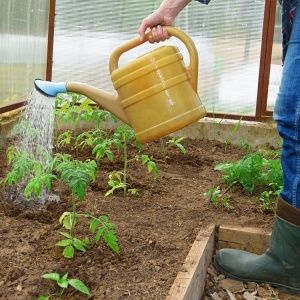
- Tomato stems Banana legs are thin. Therefore, plants without support break under the weight of the fruit. To prevent this from happening, they are tied up.
- Form a tomato banana legs into 3-5 stems. The more stems there are, the later the harvest will ripen, but the more abundant it will be. Gardeners note that when formed into 3 stems, the fruits grow larger.
- Banana legs don't need pinning. This makes them easier to care for.
- Root dressings are used 3-4 times per season. It is best to alternate organic and mineral fertilizers. Chicken droppings or mullein diluted with water are used as organic compounds. Mineral fertilizers are purchased in stores.
- Foliar feeding will not only speed up the formation of ovaries, but also reduce the risk that the plant will drop them. To do this, the bushes are sprayed with compounds containing boron.
Mistakes when growing tomatoes
There are techniques that will not only help you grow healthy plants, but also increase your yield. Here are some tips for growing tomatoes:
- It is better to use synthetic thread for tying tomatoes. If you tie up bushes with natural material, there is a risk of rot not only on the ropes, but also on the stems of the plants.
- It is important that the fruits do not lie on the ground. This will increase the risk of plants becoming infected with late blight and slugs appearing on them.
- Plants are planted in the morning or evening. You cannot water tomatoes on the day of planting. This procedure is not carried out on cloudy days.
- All damaged and incorrectly formed inflorescences are removed. Thanks to this, healthy fruits will form faster.
Diseases and pests
The Banana Legs tomato is resistant to most diseases. He rarely gets sick even from late blight.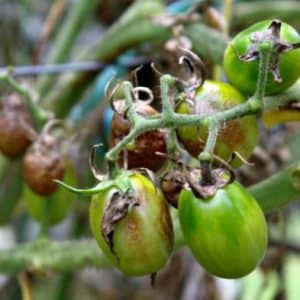
Despite the presence of immunity, tomatoes still have a risk of getting sick. To prevent this from happening, preventive methods are used.
Disinfection of seeds, containers and soil is the very first and most important stage of prevention.
It is equally important to disinfect all tools that come into contact with plants. This is where fungal and viral infections accumulate.
Compliance with the rules of watering, shaping and pinching the bush is another important step in disease prevention.
To reduce the likelihood of plant infection, they are sprayed with disinfectants. For example, Fitosporin or a solution of potassium permanganate are often used.
Insects carry fungal and viral infections. They also damage plants. Therefore, we need to fight them.
To combat harmful insects, bushes are treated with a soap solution and infusion of celandine. Large pests are collected by hand.
The nuances of growing in a greenhouse and in open ground
The Banana legs tomato is grown both in protected and open ground. You need to know several nuances of using these two methods.
When growing in a greenhouse, it is important to maintain proper humidity. This is easy to achieve - just open the windows in the room for several hours every day.
According to gardeners, in a greenhouse, banana legs tomatoes grow up to 1.5 m, while in open ground their height does not exceed 1 m. This must be taken into account when choosing a support.
In open ground, plants are not protected from night frosts. Therefore, in the evening for the first two weeks after picking, tomatoes are covered with film.
Mulching the soil mandatory when growing tomatoes in open ground. The beds are covered with hay, straw or burlap.
Advantages and disadvantages of the variety
Advantages of the variety:
- resistance to tomato diseases;
- no need for stepsoning;
- ease of care;
- unusual fruit color;
- low allergenicity of tomatoes;
- high transportability.
Not all gardeners like the taste of Banana Legs. Some tomato lovers believe that their skin is too thick.
Reviews about tomatoes
Reviews from gardeners about Banana Legs tomatoes are mixed.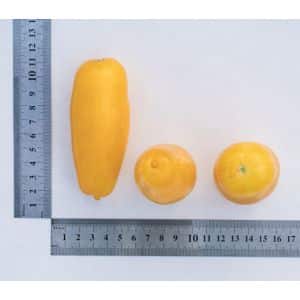
Elena Kuropatkina, Tula: “I’ve been growing Banana Legs tomatoes for two years now. Every time I plant one bed with this variety. I like their ease of care and the unusual shape of the fruit. I use it for preservation. When fresh, I prefer sweeter varieties.”
Victoria Koneva, Moscow: “I planted a Banana Legs tomato this year. I liked the photos of the fruits. The berries are really very beautiful and unusual. Otherwise, the tomato is mediocre, and its skin is a bit tough. I won’t plant any more.”
Conclusion
Banana legs tomatoes are an exotic variety characterized by long, bright yellow fruits. They contain many useful substances, but the taste is no different from the most ordinary tomatoes.
The undoubted advantage of this variety is its ease of cultivation. Banana legs are a great opportunity for a novice gardener to grow unusual tomatoes.